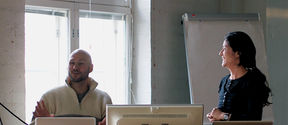Intimacy in Data Driven Culture (IDA) -2nd phase (2022 -2025)
Experimental methods for studying the effects of digitalization.

Experimental methods for studying the effects of digitalization.
Human-Computer Interaction for studying possible futures.

Future energy communities and energy self-sufficiency

From the Lab and the Studio to the Forest, the Garden and back

Ongoing research project of the INUSE research group.

A participatory design intervention for youth empowerment and energy commons.

Creative practices for transformational futures (INUSE/ENCORE)

Designing with indigenous communities: participatory interventions to support resistance and intercultural communication in the Global South
Consortium project of Aalto University and the Finnish Environment Institute (Syke) funded by the Resource Council of Finland.
The Academy of Finland funded Smart Energy Transition (SET) project focusing on analysing the future energy market disruptions in Finland, to understand how this information could be utilised in future decision-making.
The objectives of the project were to (1) Analyse the technological disruptionin smart energy and its impacts on society and its growth spearheads: cleantech, digitalization and bioeconomy. (2) Explore how different sectors can benefit from the transition, considering the institutional framework, emerging business ecosystems, competence gaps identified in pilots and the economic impacts. (3) Co-create solutions by articulating the impacts of the disruptive technologies and the opportunities, testing transition arenas, integrating the project into relevant policy processes, interacting with stakeholders and the public and producing tools supporting new business creation. Read more about the project here.
The objective of the FUCAM project (FUture Cabin for the Asian Market) was to develop a 2025+ conceptual cabin design for short and medium range aircrafts operating in the the Asian market.
The Fucam project is conducted in collaboration with Airbus Group SE and several other industrial and research partners from Europe and Japan. The project is funded by EU Horizon 2020 program, and lasts for three years starting on Feb 2016.
In the project, future user requirements for the airlines and passengers were discovered and analyzed, with a focus on Japan and two other key markets representing the Asian area (China, South-East Asia). In parallel, the project will establish a panorama of the innovative cabin technologies emerging in Europe and Japan. From these inputs, a cabin concept capable of answering the collected requirements is composed, while incorporating the most promising enabling technologies.
Furthermore, thorough studies will be conducted on the integration of this cabin concept into the aircraft (installation, reconfiguration, power and data compatibility), in order to raise its maturity level to technology readiness level 3. This will include several validation steps, involving first a functional mock-up produced in Europe, and later a full-scale customer validation mock-up produced in Japan.
Intermediaries in the energy transition: The invisible work of creating markets for sustainable energy solutions (TRIPOD) was a project that empirically research innovation intermediaries and specify the concepts and analytical tools relevant for intermediation in the context of the ongoing energy transition, i.e., the shift to low-energy and distributed renewable-based energy systems.
The objectives were to (A) identify and assess the role of intermediaries in creating, channeling and coordinating market and broader societal demand for new low carbon technologies and services and in adapting these technologies to local contexts; (B) establish the influence of different intermediary organizations and forms of work on different types of energy innovation and energy transition processes; (C) examine how energy transition intermediaries come into being, establish their functional roles, evolve, and gain legitimacy, (D) compare intermediation in different contexts (between government and citizens, energy and technology providers and users) and in different actor configurations (including or excluding certain market/societal actors) and organizational settings, and (E) distinguish between generic features of intermediation in energy transitions, and features that are specific to particular contexts or configurations.
The project is funded by Academy of Finland.
CODO – Getting collaborative design done – was an inquiry into mundane and strategic organizing of collaborative design in the early 21st century. It focuses on how user and citizen engagements get done in everyday practice in industry, in the public sector and in peer-to-peer projects currently. It uses ethnographic case-research in a suite of key sites and projects to gain deep, open-ended understanding of what it takes to get collaborative design done. An important premise of the work is that important actions in getting collaborative design done include routinized work, which hitherto has gone unnoticed in practitioners’ own writings and also neglected in the often rationalized process descriptions and accompanying case reports of design researchers. In attending to this issue the project looks deeper at the strategizing in which both designers and users engage in order to get to outcomes they desire from design collaboration.
The project rested previous research by three senior researchers (Prof. Jack Whalen (PI) Assoc Prof. Sampsa Hyysalo and Assoc Prof. Tuuli Mattelmäki ) and their re-search teams on the practices of collaborative design during the last two decades. Funding has been provided by the Academy of Finland.

Recent publications from the INUSE research group.

The current and former members of INUSE research group.